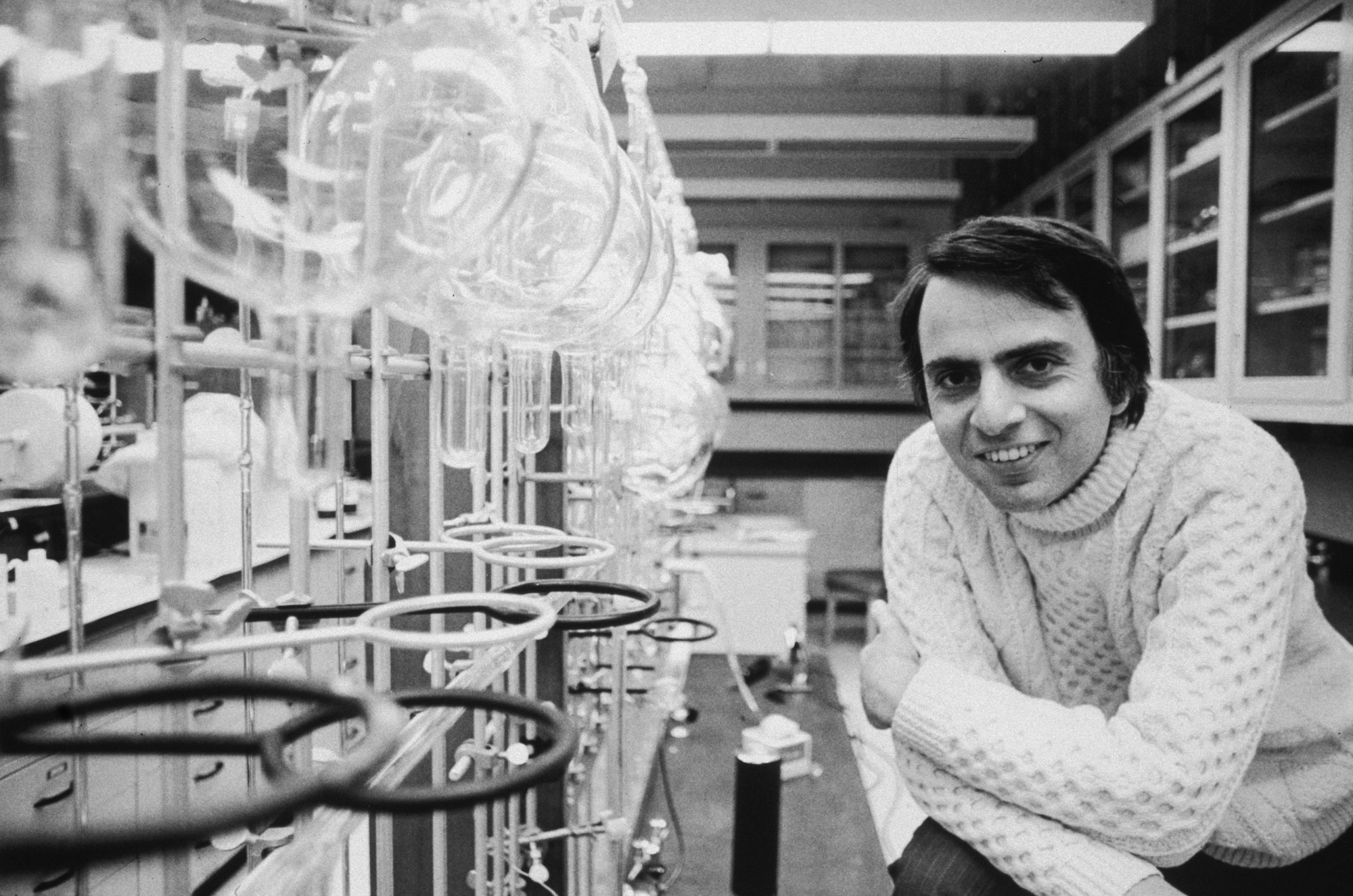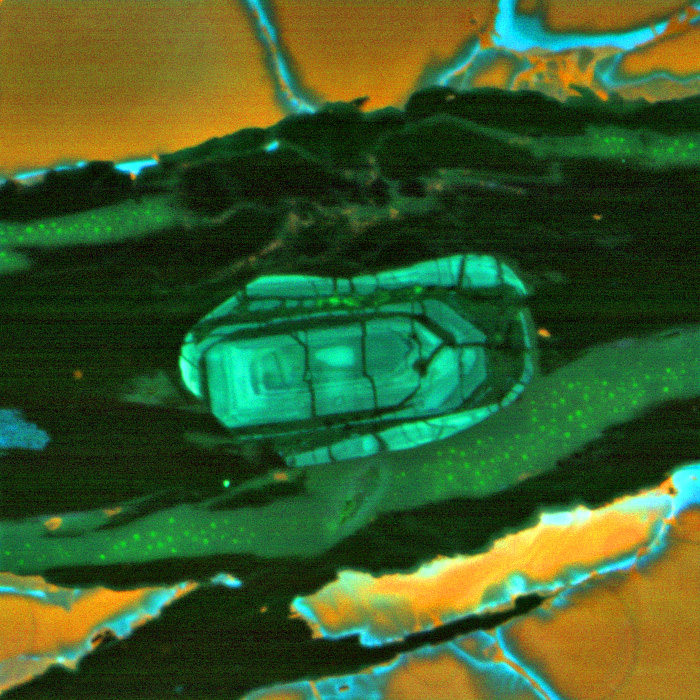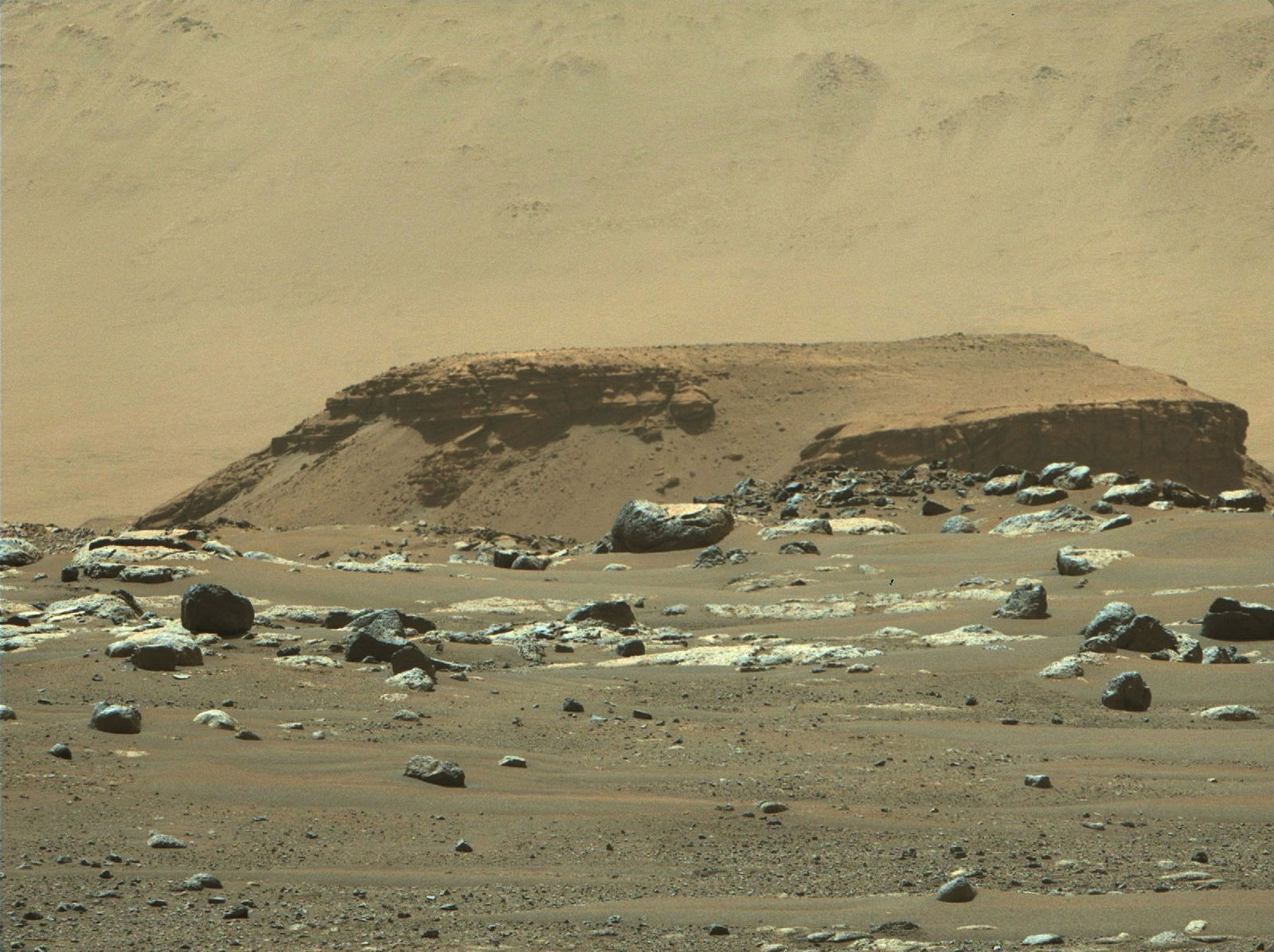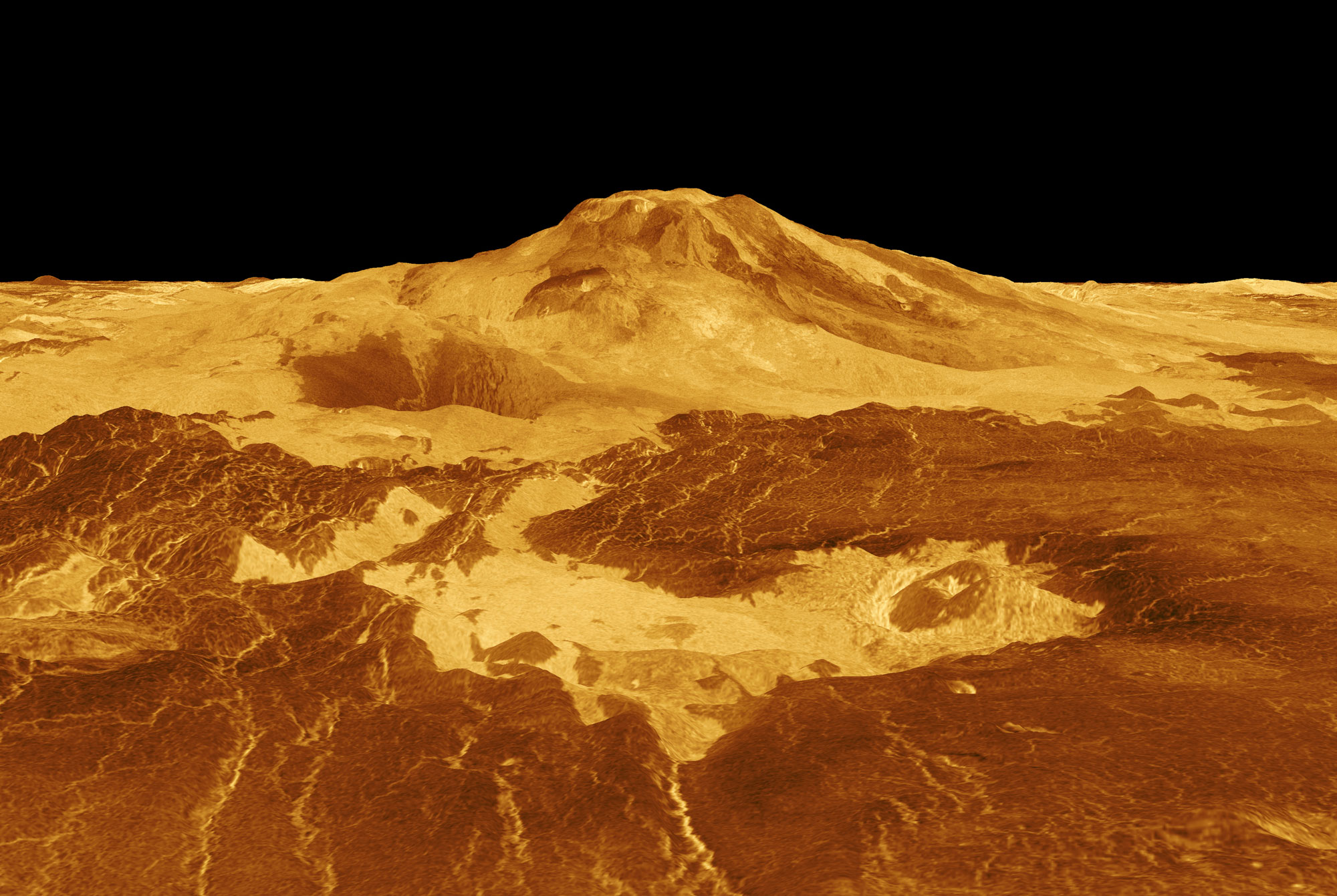A Solution to the Faint-Sun Paradox Reveals a Narrow Window for Life

In the early solar system, a close-orbiting moon would have contorted Earth’s interior, heating it from within.
James O’Brien for Quanta Magazine
Introduction
Our sun is getting brighter. If you could travel back in time to the dawn of the solar system 4.5 billion years ago, you’d find a star that was about 30% dimmer than it is now. Over the subsequent eons, it has shone more and more brilliantly — a function of the nuclear fusion process that takes place in the cores of stars like our own — and it will continue to do so until the end of its life, roughly 5 billion years from now.
That original faint sun should have led to disaster here on Earth. If our modern Earth were placed under that sun, temperatures would average about −7 degrees Celsius — too cold for liquid water to flow. “The planet should have been completely frozen,” said Toby Tyrrell, an earth system scientist at the University of Southampton. “It shouldn’t have been possible for life to develop.”
And yet it did. We know that our planet had liquid water on its surface as early as 4.4 billion years ago, and maybe even earlier, as water vapor condensed out of the atmosphere. Single-celled life seems to have sprung up shortly thereafter. And both the planet’s water and its life have persisted — despite a few close calls — to concoct the relative oasis we inhabit today.
If the sun was so faint, how was this possible?
The faint young sun paradox, as it’s known, has vexed scientists for decades. But recent work has led many researchers to think that we now have a solid hold on the problem. Old ideas have been refined, while new ideas — including one involving an unnervingly close moon that sculpted tidal waves the size of skyscrapers — have helped to fill the few remaining gaps in our understanding.
Scientists have also come to realize that the faint young sun paradox carries important implications not only for Earth, but for our understanding of how life in general might come to be. Did our world, even in its optimal location around a relatively sedate star, manage to produce life by only the slimmest of margins? What might that mean for the prospect of life elsewhere? “It’s a really fundamental question concerning the habitability of Earth over all its history,” said Benjamin Charnay, a planetary scientist at the Paris Observatory, “and has strong implications concerning the habitability of exoplanets.”
In exploring the mysteries of the faint young sun problem, we have opened up the history of our world like never before. In doing so, we’re discovering that what was once a paradox may in fact reveal the very reason for our existence.
The Paradox
In the mid-20th century, scientists started to understand the mechanics that drive the evolution of stars like our sun. Deep in a star’s core, hydrogen fuses into helium, producing energy. As the amount of hydrogen decreases, the core shrinks, which in turn boosts the fusion rate. The star gets brighter over time.

Carl Sagan in 1974, two years after his suggestion that greenhouse gasses might solve the faint young sun paradox.
Santi Visalli Inc./Getty Images
In 1958, the German American astrophysicist Martin Schwarzschild and the British astronomer Fred Hoyle used this knowledge to separately arrive at the same conclusion: When our sun first formed, it must have had only about 70% of the luminosity it has now. “The very first models of stellar evolution predicted that,” said James Kasting, a geoscientist at Pennsylvania State University. In the 1960s, however, scientists began to find evidence of water on Earth dating back 4 billion years. This appeared to contradict the solar models; Earth should not have been warm enough under the faint young sun to possess liquid water. One paper in 1965, in an effort to solve the discrepancy, suggested that either the sun was older than we thought, or the model of our sun’s evolution “may require some modification to permit higher luminosities.”
The American astronomers Carl Sagan and George Mullen made a more substantial attempt to resolve the paradox in 1972, performing the first detailed analysis of the faint young sun problem. They suggested that a thicker atmosphere on the early Earth might have been able to trap more heat, keeping the planet warm enough to support liquid water. The greenhouse gas they put forward was ammonia.
Ammonia did not last long as a potential solution to the paradox, however. “It’s destroyed by solar ultraviolet radiation,” said Georg Feulner, a climate researcher at the Potsdam Institute for Climate Impact Research. “People realized later on that it just doesn’t work out.” In the late 1970s, scientists turned to another greenhouse gas — carbon dioxide — as a possible solution. “Carbon dioxide is a lot less problematic,” said Feulner. “There’s a lot of carbon in the Earth’s system early on, so it’s a reasonable assumption you can produce significant amounts of carbon dioxide in the atmosphere.”
Kasting and his colleagues explored carbon dioxide’s possible effects in 1981, noting that volcanoes could have released enough of it to overcome the faint young sun problem. Even if Earth did manage to freeze over — which appears to have happened on at least three occasions — volcanoes poking their noses through the ice might reverse the process. “The resultant large greenhouse effect should melt the ice cover in a geologically short period of time,” Kasting and his colleagues wrote.
Samuel Velasco/Quanta Magazine; source: Catling and Kasting (2017)
But evidence for the hypothesis was extremely hard to come by — we can’t just grab a sample of the atmosphere from 4 billion years ago. In the absence of geological corroboration, other possibilities emerged. Perhaps high levels of carbon dioxide reduced the amount of reflective low clouds that would have bounced sunlight back into space. Or maybe the sun was more massive in the distant past, counteracting the diminished fusion process in its core. “If you increase the mass of the sun by 5%, then the sun initially would be just as bright as it is now, and we wouldn’t have a faint young sun problem at all,” said Piet Martens of Georgia State University. Most researchers view this idea skeptically, however.
A solution to the faint young sun problem required a better understanding of Earth’s earliest periods: the Hadean eon, which lasted from 4.6 billion to 4 billion years ago, and the subsequent Archean eon that ended 2.5 billion years ago. Scientists needed to find out when water and life first arose, and to get a handle on Earth’s early atmosphere. Fortunately, answers weren’t far away.
Water, Water, Everywhere
At the dawn of the Hadean, an object at least the size of Mars, and perhaps twice as big, barreled into the young proto-Earth. The collision formed the moon and essentially reset the timeline of our planet to zero. It also likely sent temperatures on Earth soaring, with a vast magma ocean encompassing the planet.

James Kasting has been working on the faint young sun paradox for over four decades.
Penn State
That magma ocean could have cooled in just a few tens of millions of years, allowing a more recognizable planet to take shape. Evidence for this comes from tiny crystals called zircons.
“Zircons are the oldest known terrestrial solids on our planet today,” said Dustin Trail, an earth scientist at the University of Rochester who published work on their properties in 2018. “They have ages that extend back 4.4 billion years.” Studying the ratio of different forms of oxygen in some of these zircons shows that they may have interacted with water as far back as 4.38 billion years ago, pointing to the presence of liquid water and perhaps oceans on our planet almost immediately after the magma ocean phase. “It’s remarkable when you think about it,” said Trail. “It effectively tells you that 150 million years after the solar system formed, we may have had a habitable planet.”
Just 300 million years later — 4.1 billion years ago — some of the first evidence of life appears. In 2015, Elizabeth Bell, a geoscientist at the University of California, Los Angeles, and colleagues found carbon from biological sources inside zircons. “We inferred that these potentially were the remains of organisms that lived at or before 4.1 billion years ago when they got trapped in this crystal,” Bell said.

A rectangular zircon at the center of a larger mineral conglomerate taken from the Jack Hills of Western Australia. Some zircons from the Jack Hills have been dated to 4.4 billion years before the present day, making them the oldest materials on Earth.
Nicholas Tailby
We don’t have reliable measurements of atmospheric carbon dioxide from that long ago. But as far back as we can look, we see that there was a lot of it. In January 2020, Owen Lehmer, a planetary scientist now at NASA’s Ames Research Center in California, and colleagues published work analyzing the composition of meteorites from 2.7 billion years ago. They found that as the meteorites passed through our atmosphere, they preserved a record of the atmospheric composition. The researchers showed that it may have been 70% carbon dioxide or more, compared to just 0.04% today.
“It’s really quite abundant in the atmosphere at that time,” said Lehmer. “Adding a bunch of carbon dioxide is certainly in line with keeping the young Earth warm and preventing a giant snowball.”
When the Snowball Came
Temperatures weren’t always so balmy. On several occasions “the thermostat failed spectacularly,” said Feulner. Around 2.4 billion years ago, glaciers pushed all the way to the equator. “We believe at this time we had the first ‘snowball Earth’ event,” said Andreas Pack, a geochemist at the University of Göttingen. “The entire oceans were frozen, probably [under] several hundred meters of ice.” Scientists think it happened when too much carbon dioxide was pulled out of the atmosphere — absorbed by silicate rock on land and on the seafloor in a process called rock weathering — although the exact trigger is unknown.
Additional carbon dioxide from volcanoes may have allowed our planet to reverse the process. Then about 2 billion years ago, the sun became luminous enough — at more than 80% of its current value — to support liquid water. “The sun eventually gets warm enough to provide the insolation that’s needed,” said Renu Malhotra, a planetary scientist at the University of Arizona. (Additional snowball Earth events are thought to have occurred 700 million and 635 million years ago, however. Volcanic eruptions may have been the cause of both the beginning and end of each of these periods.)

Renu Malhotra, a planetary scientist at the University of Arizona.
Courtesy of Renu Malhotra
Over the past decade, advanced modeling of our planet’s carbon cycle has suggested that early in Earth’s history, less carbon dioxide may have been needed than researchers once thought. Other factors, such as the production of methane by living things, may have helped to boost the greenhouse effect.
In November 2021, René Heller of the Max Planck Institute for Solar System Research in Germany and colleagues came up with another potential source of heat. Shortly after the moon formed, it was likely 15 times closer to Earth than it is today. The moon’s gravity would have had a huge impact, creating enormous tidal waves that towered 2 kilometers above any magma or liquid-water oceans present. It would also have pushed and pulled Earth’s interior, generating extreme tidal heating that increased the planet’s temperature. While not enough to solve the faint young sun paradox on its own, the moon could have given Earth a vital boost over our planet’s first 100 million to 300 million years, increasing Earth’s temperature by several degrees and helping to drive volcanic activity across the surface.
“If we include tidal heating, the riddle becomes less severe,” said Heller. “Without tidal heating, I think the entire Earth would be a global snowball.”
The Benefits of a Faint Sun
Other recent work has suggested the faint young sun may not have been a problem at all, but a savior. Had the sun possessed between 92% and 95% of its present luminosity 4.5 billion years ago, Earth might have become too hot, resulting in a “steam Earth,” with water vapor unable to condense out of the atmosphere. “Earth would never have been able to actually form its first oceans,” said Martin Turbet, an astrophysicist at the French National Center for Scientific Research. “The faint young sun may have been a necessity for the habitability of Earth.” His work, published in October, modeled the early climate of Venus, finding that the planet was never cool enough to support liquid water, even with a fainter sun. If the early sun hadn’t been faint, our planet might have shared Venus’s fate.
Upcoming missions to Venus planned by NASA and the European Space Agency may be able to tell us if this idea is correct by looking for signs of ancient water. If they don’t find any, perhaps we should be grateful. “It’s a faint young sun benefit,” said Kasting. A hot sun “would have boiled the oceans away.”


The Martian surface (top) as seen from the Perseverance rover shows evidence of ancient lake beds. Venus, on the other hand, has always been too hot for liquid water to condense out of the atmosphere.
Alt text: Images of the surfaces or Mars and Venus.
The Martian surface (left) as seen from the Perseverance rover shows evidence of ancient lake beds. Venus (right), on the other hand, has always been too hot for liquid water to condense out of the atmosphere.
Mars presents a trickier conundrum. According to new data from NASA’s Perseverance rover, Mars appears to have had rivers and lakes on its surface at least 3.7 billion years ago. It’s unclear how that would have been possible at its greater distance from the sun.
“On Mars the puzzle is enhanced,” said Kirsten Siebach, a planetary scientist at Rice University and a member of the science team for multiple robotic Mars missions, including Perseverance. “Ancient Mars would have required twice the greenhouse effect we have on Earth today.” Samples being collected by Perseverance, to be returned to Earth in the 2030s, could tell us if this was possible.
For planets in other solar systems, the faint young sun problem complicates the question of extraterrestrial life. In December 2020, Tyrrell calculated that Earth’s continuing habitability is mostly due to chance. He created a computer model of 100,000 planets. Each started out as habitable. He then subjected each planet to 100 simulations of various climate feedback scenarios. For 91% of the planets, not a single simulation kept the planet habitable over geological timescales. “Earth’s success was not an inevitable outcome but rather was contingent,” he wrote. “It could have gone either way.” Thus, in order for exoplanets to have the potential to develop life, perhaps they need to have the right ingredients in just the right circumstances — like Earth.
We know that life under our faint young sun was possible, and now we might know why. What we are starting to see is just how lucky we may have been in avoiding becoming a permanent snowball Earth or even a steam Earth. Somehow, conditions were just right on our planet, keeping us in this narrow window between being frozen solid and evaporating to oblivion, and allowing us to survive — despite a few near misses. “There’s a huge discussion about the requirements for habitability,” said Feulner. “Even on Earth, things could have gone wrong easily.”





